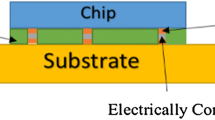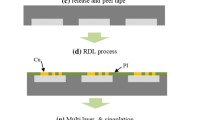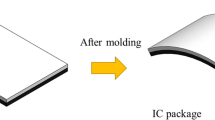Abstract
Epoxy molded compounds (EMCs) containing a high percentage of filler in the form of silicon oxide particles are used to reduce the difference in the temperature coefficient of linear expansion between the die and the sealing material when dies packaging in plastic. However, in addition to the die, the commutation substrate has a significant effect on the level of thermomechanical stresses in the package. In the 3D integration in a microassembly, vertical interconnects combines several substrates that can be made from different dielectrics. This paper shows that sealing materials with different temperature coefficients of linear expansion in the outer and inner parts of the product can reduce the level of thermal stresses in such a structure. The dependences of the thermomechanical stress and deformation of the microassembly on the number of levels and the amount of filler in the outer sealing compound are determined. The study is carried out by the computer simulation of various designs of microassemblies sealed with compounds with different values of the temperature and mechanical parameters. Based on the obtained dependency graphs, the optimal values of the filler content in the outer and inner compounds are established to ensure the minimum temperature and mechanical (under the action of acceleration) deformation of microassemblies at a different number of levels.





Similar content being viewed by others
REFERENCES
Plante, J. and Shaw, H., Evaluation of 3D Plus packaging test structures for NASA Goddard Space Flight Center, in Proceedings of the European Space Components Conference, ESCCON 2002, September 24–27, 2002, Toulouse, France, Noordwijk: ESA Publ. Div., 2002, p. 213.
Fedorov, M., High-tech 3D Plus memory chips, Kompon. Tekhnol., 2006, no. 9 (62), pp. 72–75.
Albert, D. and Gann, K., Stackable microcircuit layer formed from a plastic encap-sulated microcircuit and method of making the same, US Patent no. US20020100600A1, 2002.
Wafer Level Packaging reaches new heights. http:// www.yole.fr/Advanced_Packaging_Monitor_Q1.aspx. Accessed November 24, 2021.
Materials for Advanced Packaging, Lu, D. and Wong, C.P., Eds., Cham: Springer, 2017, 2nd ed.
Soon Wee Ho, Myo Ei Pa Pa, Fernandez, M.D., et al., Development of Via in Mold (ViM) for embedded wafer level package (EWMLP), in Proceedings of the 2011 IEEE 13th Electronics Packaging Technology Conference, Singapore: IEEE, 2011, pp. 417–422. https://doi.org/10.1109/EPTC.2011.6184457
Braun, T., Töpper, M., Becker, K.-F., et al., Opportunities of Fan-out Wafer Level Packaging (FOWLP) for RF applications, in Proceedings of the 2016 IEEE 16th Topical Meeting on Silicon Monolithic Integrated Circuits in RF Systems (SiRF), Austin, TX: IEEE, 2016, pp. 35–37. https://doi.org/10.1109/SIRF.2016.7445461
Gotro, J., Polymers in Electronic Packaging. Part 4: Molding Process for Epoxy Mold Compounds for Fan-out Wafer Level Packaging. https://polymerinnovationblog.com/polymers-electronic-packaging-part-four-molding-process-epoxy-mold-compounds-fan-wafer-level-packaging/. Accessed November 24, 2021.
Li, R., Yang, D., Zhang, P., et al., Effects of high-temperature storage on the elasticity modulus of an epoxy molding compound, Materials, 2019, vol. 12, no. 4, p. 684. https://doi.org/10.3390/ma12040684
Zeng, J., Fu, R., Shen, Yu., et al., High thermal conductive epoxy molding compound with thermal conductive pathway, J. Appl. Polym. Sci., 2009, vol. 113, no. 4, pp. 2117–2125. https://doi.org/10.1002/app.30045
Kurin, S.V., Shafigullin, L.N., Lakhno, A.V., and Bobryshev, A.A., Polimernye kompozity s vysokimi uprugoprochnostnymi kharakteristikami (Polymer Composites with High Elastic Strength Characteristics), Penza: PGUAS, 2016.
Chao, S., Liaw, Y., and Chou, J.-H., The effects of filler shape, type, and size on the properties of encapsulation molding components, Electronics, 2021, vol. 10, no. 2, p. 98. https://doi.org/10.3390/electronics10020098
Carias, V., Thompson, J., Myers, Ph., Jr., et al., Development of mold compounds with ultralow coefficient of thermal expansion and high glass transition temperature for fan-out wafer-level packaging, IEEE Trans. Compon. Packag. Manuf. Technol., 2015, vol. 5, no. 7, pp. 921–929. https://doi.org/10.1109/TCPMT.2015.2443072
Chung, S.-L. and Lin, J.-S., Thermal conductivity of epoxy resin composites filled with combustion synthesized h-BN particles, Molecules, 2016, vol. 21, no. 5, p. 670. https://doi.org/10.3390/molecules21050670
Shibuya, M. and Nguyen, L., High thermal conductivity mold compounds for advanced packaging applications, in Proceedings of the 2017 IEEE 67th Electronic Components and Technology Conference ECTC, Orlando, FL: IEEE, 2017, pp. 1334–1339. https://doi.org/10.1109/ECTC.2017.296
Funding
This study was supported by the Russian Science Foundation (grant no. 20-37-90096).
Author information
Authors and Affiliations
Corresponding author
Rights and permissions
About this article
Cite this article
Vertyanov, D.V., Belyakov, I.A., Pogudkin, A.V. et al. Study of the Influence of Mechanical and Temperature Effects on the Level of Stresses and Deformations in 3D Microassemblies Hermetically Sealed with Two Types of Compounds. Russ Microelectron 51, 531–538 (2022). https://doi.org/10.1134/S1063739722070137
Received:
Revised:
Accepted:
Published:
Issue Date:
DOI: https://doi.org/10.1134/S1063739722070137




